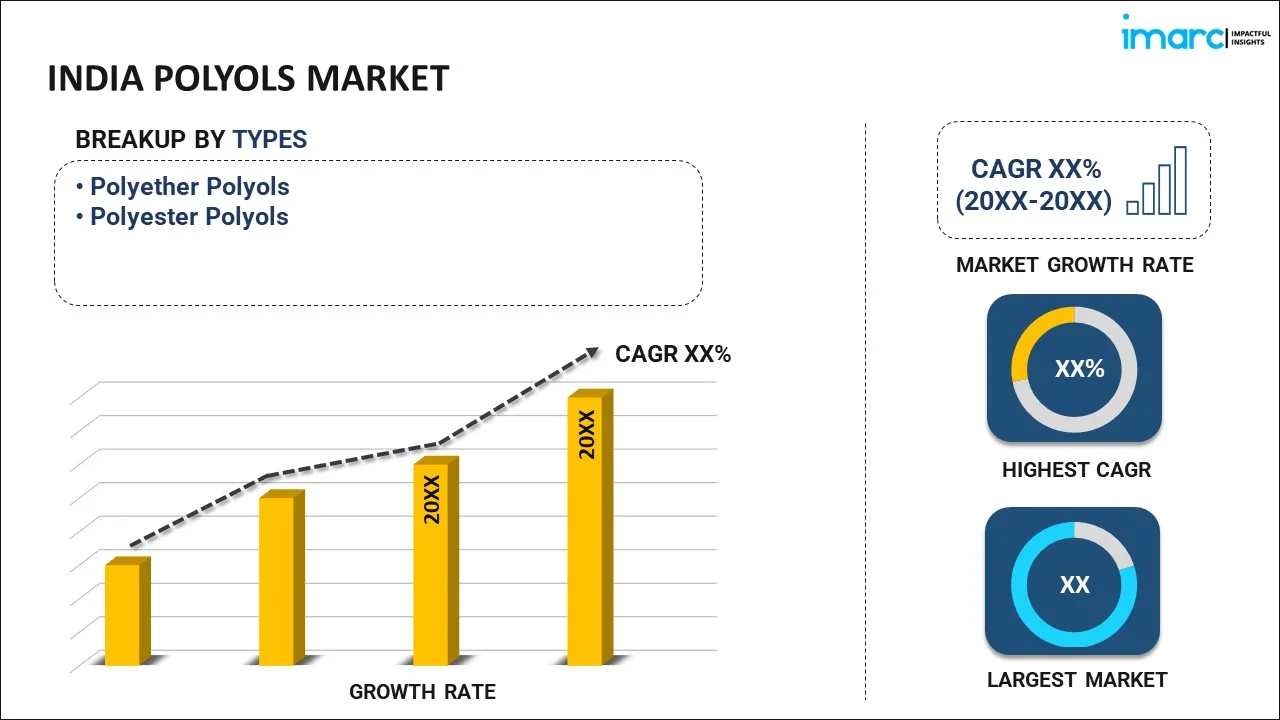
India Polyols Market Report by Type (Polyether Polyols, Polyester Polyols), Application (Flexible Polyurethane Foams, Rigid Polyurethane Foams, CASE (Coatings, Adhesives, Sealants & Elastomers), and Others), Industry (Carpet Backing, Packaging, Furniture, Automotive, Building & Construction, Electronics, Footwear, and Others), and Region 2025-2033
Market Overview:
The India polyols market size reached 484.5 Kilo Tons in 2024. Looking forward, IMARC Group expects the market to reach 864.4 Kilo Tons by 2033, exhibiting a growth rate (CAGR) of 6.31% during 2025-2033.
|
Report Attribute
|
Key Statistics
|
|---|---|
|
Base Year
|
2024
|
|
Forecast Years
|
2025-2033
|
|
Historical Years
|
2019-2024
|
|
Market Size in 2024
|
484.5 Kilo Tons |
|
Market Forecast in 2033
|
864.4 Kilo Tons |
| Market Growth Rate 2025-2033 | 6.31% |
Polyols, also known as sugar alcohols, are organic compounds that consist of multiple hydroxyl groups. They contain reduced-calorie carbohydrates that provide the taste and texture of table sugar with less or half of the calories. Consequently, they are utilized in the food and beverage industry as artificial sweeteners to produce sugar-free products like chewing gum, candies, ice cream, baked goods, and fruit spreads. Apart from this, polyols have wide-ranging applications in the packaging, furniture, automotive, electronics, and building and construction industries.
The India polyols market is primarily driven by the increasing demand for different derivates of polyols, such as flexible polyurethane foams, elastomers, coatings. These products are extensively used by the automotive industry to manufacture interior parts of automobiles. Besides this, the growing construction industry driven by the increasing population and housing requirements has increased the consumption of polyol-based building materials, such as insulation protective components, exterior panels, and housing electronics. As these materials aid in conserving energy and minimizing greenhouse gas emissions, their increased demand is stimulating the growth of the market.
Key Market Segmentation:
IMARC Group provides an analysis of the key trends in each sub-segment of the India polyols market report, along with forecasts at the country and regional level from 2025-2033. Our report has categorized the market based on type, application and industry.
Breakup by Type:

- Polyether Polyols
- Polyester Polyols
Breakup by Application:
- Flexible Polyurethane Foams
- Rigid Polyurethane Foams
- CASE (Coatings, Adhesives, Sealants & Elastomers)
- Others
Breakup by Industry:
- Carpet Backing
- Packaging
- Furniture
- Automotive
- Building & Construction
- Electronics
- Footwear
- Others
Breakup by Region:
- North India
- West and Central India
- South India
- East India
Competitive Landscape:
The competitive landscape of the industry has also been examined along with the profiles of the key players.
Report Coverage:
| Report Features | Details |
|---|---|
| Base Year of the Analysis | 2024 |
| Historical Period | 2019-2024 |
| Forecast Period | 2025-2033 |
| Units | '000 Tons, Million USD |
| Segment Coverage | Type, Application, Industry, Region |
| Region Covered | North India, West and Central India, South India, East India |
| Customization Scope | 10% Free Customization |
| Post-Sale Analyst Support | 10-12 Weeks |
| Delivery Format | PDF and Excel through Email (We can also provide the editable version of the report in PPT/Word format on special request) |
Key Questions Answered in This Report
The India polyols market reached a volume of 484.5 Kilo Tons in 2024.
We expect the India polyols market to exhibit a CAGR of 6.31% during 2025-2033.
The rising demand for polyols across the Food and Beverage (F&B) industry as artificial sweeteners for producing various sugar-free products, including chewing gum, candies, ice cream, baked goods, etc., is primarily driving the India polyols market.
The sudden outbreak of the COVID-19 pandemic had led to the implementation of stringent lockdown regulations across the nation, resulting in the temporary halt in numerous production activities for polyols.
Based on the type, the India polyols market can be categorized into polyether polyols and polyester polyols. Currently, polyether polyols account for the majority of the total market share.
Based on the application, the India polyols market has been segregated into flexible polyurethane foams, rigid polyurethane foams, CASE (Coatings, Adhesives, Sealants & Elastomers), and others. Among these, flexible polyurethane foams currently exhibit a clear dominance in the market.
Based on the industry, the India polyols market can be bifurcated into carpet backing, packaging, furniture, automotive, building & construction, electronics, footwear, and others. Currently, the furniture industry holds the largest market share.
On a regional level, the market has been classified into North India, West and Central India, South India, and East India.
Need more help?
- Speak to our experienced analysts for insights on the current market scenarios.
- Include additional segments and countries to customize the report as per your requirement.
- Gain an unparalleled competitive advantage in your domain by understanding how to utilize the report and positively impacting your operations and revenue.
- For further assistance, please connect with our analysts.
 Inquire Before Buying
Inquire Before Buying
 Speak to an Analyst
Speak to an Analyst
 Request Brochure
Request Brochure
 Request Customization
Request Customization




.webp)




.webp)












